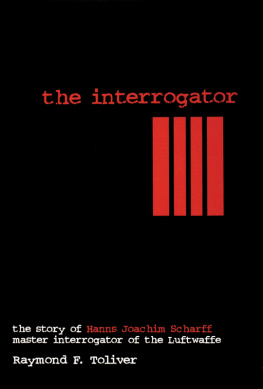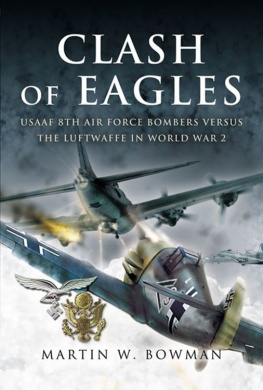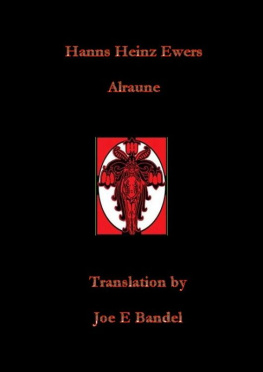Book Design by Robert Biondi
Copyright 1997 by Raymond F. Toliver.
Library of Congress Control Number: 96-72252.
All rights reserved. No part of this work may be reproduced or used in any form or by any meansgraphic, electronic, or mechanical, including photocopying or information storage and retrieval systemswithout written permission from the publisher.
The scanning, uploading and distribution of this book or any part thereof via the Internet or via any other means without the permission of the publisher is illegal and punishable by law. Please purchase only authorized editions and do not participate in or encourage the electronic piracy of copyrighted materials. Schiffer, Schiffer Publishing Ltd. & Design, and the Design of pen and inkwell are registered trademarks of Schiffer Publishing Ltd.
ISBN: 978-0-7643-0261-9
978-1-5073-0180-7 (E PUB)
Printed in China
Schiffer Books are available at special discounts for bulk purchases for sales promotions or premiums. Special editions, including personalized covers, corporate imprints, and excerpts can be created in large quantities for special needs. For more information contact the publisher:
Published by Schiffer Publishing, Ltd.
4880 Lower Valley Road
Atglen, PA 19310
Phone: (610) 593-1777; Fax: (610) 593-2002
E-mail:
Web: www.schifferbooks.com | For our complete selection of fine books on this and related subjects, please visit our website at www.schifferbooks.com. You may also write for a free catalog. We are always looking for people to write books on new and related subjects. If you have an idea for a book, please contact us at . |
PREFACE
In the early 1950s, while doing the research for a book later titled Fighter Aces of the U.S.A., many of the aces I interviewed had been POWs in Germany. Almost to a man they commented that their interrogator at the Luftwaffe interrogation center at Oberursel had been a first-class gentleman named Hanns Scharff. Some swore he was an officer dressed in enlisted clothing, some said he was a member of the aristocracy, and all said he was one of the most intelligent of all men they had ever met. Then I was told that he was a Luftwaffe enlisted man with the rank of Gefreiter (the equivalent of corporal).
This really whet my curiosity, so I began a long and almost fruitless search for him. I wanted to hear his side of the story and try to determine what it was that made this man the Luftwaffes most successful interrogator. I was told by one source that he lived in Germany, and another told me he had passed away shortly after the war.
The logjam broke, however, when I read an article in the Air Force Magazine, authored by an ex-POW named Royal D. Frey. The story mentioned Hanns Scharff and stated that he lived in the Los Angeles area. Now, I lived in Encino, a suburb of Los Angeles, so I picked up the San Fernando Valley phone book and there he was! He lived in the Hollywood Hills area, just twelve miles from my home. A quick phone call, and Hannss wife, Sabine, was asking me who I was and if Hanns knows me. That phone call was the beginning of this book and of a friendship that flourished as long as he lived.
Scharffs life story, and in particular his experiences with American fighter pilots from the 8th and 9th US Air Forces who had been downed and captured by the Germans, was so gripping that my other writing projects were pushed aside.
While it was a self-satisfying accomplishment to see this book published, the most rewarding part was acquiring the friendship of Hanns Scharff. I have tried to catch the essence of his speech and grammar (European grammar) throughout the book and hope I have succeeded.
Auswertestelle West was established in 1941 as the principal Air Force intelligence center for the whole of the Western theater of operations. Its main purpose was to obtain operational information through the interrogation of captured air crews, and through evaluation of documents and other materials recovered from crashed enemy aircraft.
The center was located at Oberursel and is often mis-called Dulag Luft, and it may have actually functioned under that misnomer until the true transit camp was established at Wetzlar and officially called Dulag Luft. Dulag Luft actually translates into transit camp.
Oberstleutnant (Lt. Colonel) Killinger was the commandant of Auswertestelle West beginning in 1941 and was responsible for the growth of the camp from a very small operation in 1941 to the important center it finally became. In 1941 it had a small staff of about fifty, with only four interrogators, and only 400 to 500 POWs passed through at that time. To illustrate the constant growth of the operation, it should be noted that in 1942 about 3,000 POWs were interrogated. In 1943 over 8,000 POWs passed through, and in 1944 more than 29,000 Allied airmen were processed.
The number of interrogators also had to grow in order to handle this increasing workload. In 1943 there were thirty to forty interrogators, and in 1944, sixty to sixty-five interrogators and about 550 total personnel in all departments. The departments included interrogating, evaluation, press, radio listening, broadcasting, photographic, reception, and sanitary.
The Interrogator was originally published in 1978 by Aero Publishers of Fallbrook, California. Mr. Ernest Gentle, the president of Aero, was as impressed as the author by Mr. Scharff and has also developed a friendship with him. Sadly, Aero went out of business, so Schiffer Publishing is bringing this new edition of the book to the public. This new edition, published in 1997, has been revised, corrected, and updated and reflects many experiences that have taken place since the first edition. Literally hundreds of ex-POWs have contacted Scharff and the author since the book was published, praising once again and saluting their honorable captor. To a man they have expressed a desire to meet him again or to write or telephone him. Scharff has a right to feel very special, and it all happened because he was gentle and believed he could get more information from an interrogatee through kindness rather than through bullying and threats. He was professional in his approach to his job, and he always got the information he was seeking from each POW.
Major (later Lieutenant General) Gerald W. Johnson, United States Air Force, 56th Fighter Group, one of Americas top fighter aces, was downed and captured by the Germans on 27 March 1944. During interrogations at the Luftwaffe Intelligence and Evaluation Center at Oberursel, Johnson left with the impression of Scharff as an unswerving and loyal soldier, and an alert, correct, and polite gentleman-officer.









